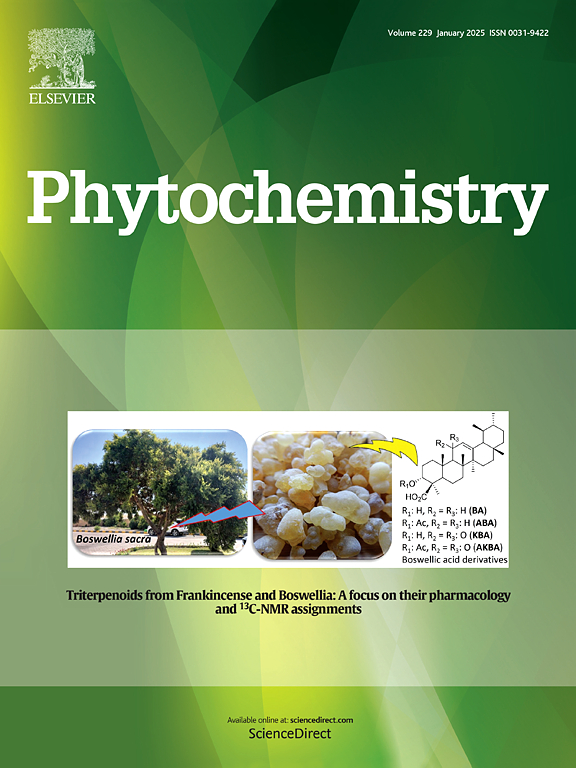雪桐木脂素E-K:一种特殊的具有肝保护作用的螺苯并呋喃类二苯并环二烯木脂素。
IF 3.4
2区 生物学
Q2 BIOCHEMISTRY & MOLECULAR BIOLOGY
引用次数: 0
摘要
对Kadsura heteroclita根进行进一步的植物化学研究,分离出16种螺苯并呋喃类二苯并环二烯木脂素,其中包括6种先前未被描述的木脂素E-J(1-6),以及1种首次从天然来源中分离得到的木脂素K(7)。利用一维和二维核磁共振技术以及计算的ECD谱对1-7的结构和绝对构型进行了分析。此外,通过单晶x射线晶体学分析进一步证实了1和5的绝对构型。首次报道了已知化合物13和14的x射线结构,并对五味子素G的错配结构进行了修正。大多数分离的化合物对h2o2诱导的HepG2细胞损伤具有肝保护作用。化合物6、11、13和15在20 μM时具有明显的保护作用,且15的细胞活力高于阳性药物(双环醇)。本文章由计算机程序翻译,如有差异,请以英文原文为准。

Xuetonlignans E-K, unusual spirobenzofuranoid dibenzocyclooctadiene lignans with hepatoprotective activity from the roots of Kadsura heteroclita
Further phytochemical investigation on the roots of Kadsura heteroclita led to the isolation of sixteen spirobenzofuranoid dibenzocyclooctadiene lignans, including six previously undescribed ones named xuetonlignans E-J (1–6), and one being isolated for the first time from a natural source, xuetonlignan K (7). The structures and absolute configurations of 1–7 were elucidated by 1D and 2D NMR techniques, as well as calculated ECD spectra. Additionally, the absolute configurations of 1 and 5 were further confirmed by single crystal X-ray crystallographic analysis. The X-ray structures of the known compounds 13 and 14 were reported for the first time, and the misassigned structure of schizanrin G was corrected. Most of the isolated compounds were tested for their hepatoprotective effects against H2O2-induced damage in HepG2 cells. Notably, compounds 6, 11, 13, and 15 showed apparent protective effects at 20 μM, and the cell viability of 15 was greater than that of the positive drug (bicyclol).
求助全文
通过发布文献求助,成功后即可免费获取论文全文。
去求助
来源期刊

Phytochemistry
生物-植物科学
CiteScore
6.40
自引率
7.90%
发文量
443
审稿时长
39 days
期刊介绍:
Phytochemistry is a leading international journal publishing studies of plant chemistry, biochemistry, molecular biology and genetics, structure and bioactivities of phytochemicals, including ''-omics'' and bioinformatics/computational biology approaches. Phytochemistry is a primary source for papers dealing with phytochemicals, especially reports concerning their biosynthesis, regulation, and biological properties both in planta and as bioactive principles. Articles are published online as soon as possible as Articles-in-Press and in 12 volumes per year. Occasional topic-focussed special issues are published composed of papers from invited authors.
 求助内容:
求助内容: 应助结果提醒方式:
应助结果提醒方式:


